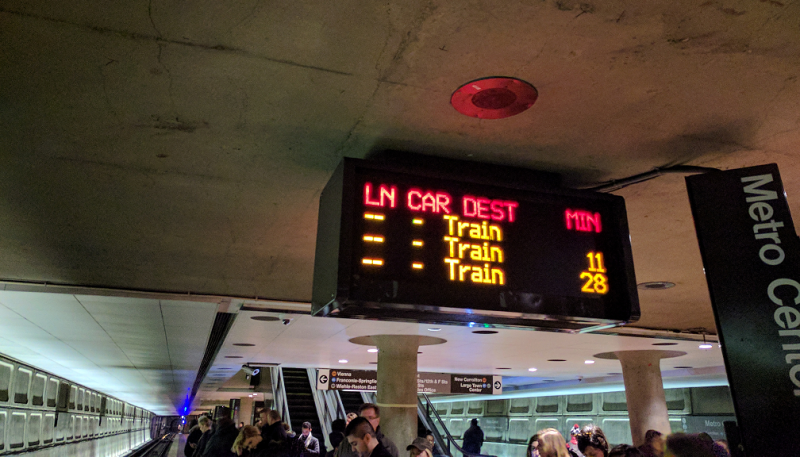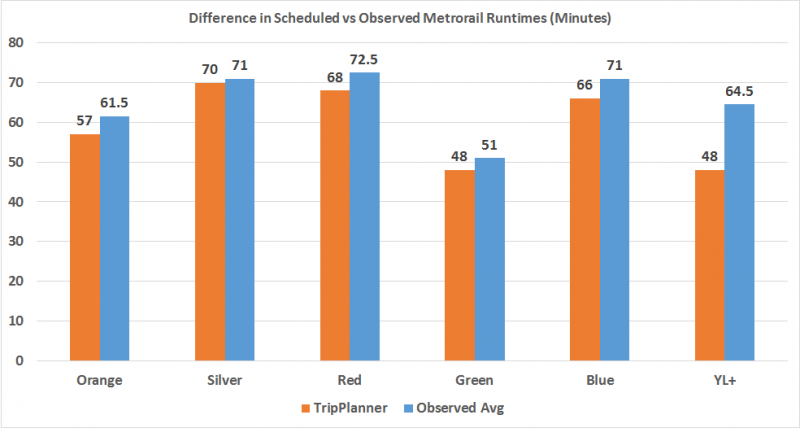Metro’s schedules aren’t as realistic as they should be

Passenger Information Display System at Metro Center during a track shutdown between Smithsonian and Federal Center SW, March 2017. Photo by the author. Image by the author.
It’s not possible for trains to get from one end of their line to the other in the time Metro’s schedules say they do. In fact, Metro’s Trip Planner tool underestimates actual travel times by about 10 percent. One upside of Metro’s coming schedule changes, which go into effect on June 25, is that its schedules will be updated to be more accurate.
Metro’s trains usually run from all the way from one end of a rail line to the other. The time it takes the train to complete its scheduled trip is called its “run time.” According to data collected in February and March by MetroHero, a Metrobus/Metrorail transit app that crunches Metro’s train data, Metro’s Trip Planner underestimates end-to-end run times by about 10 percent.
For instance, Metro’s Trip Planner says it takes an Orange Line train 57 minutes to travel from Vienna to New Carrollton, or vice versa. But that essentially assumes that the trains are running faster than they actually are. It actually takes Orange Line trains about 61.5 minutes to make that trip, which is 4.5 minutes longer than what the schedule says, or about 7.9 percent more time.
A comparison of the schedule travel time to the actual travel time. Data provided by MetroHero during the February 28th 2017 to March 4th 2017 time period. Data availability was limited due to the various severe service impacts and changes caused by SafeTrack. Image by the author.
A schedule that doesn’t match reality is bad for Metro’s ability to space trains. Assuming trains run six minutes apart when in reality they’ll always end up bunching means more stopping in tunnels and at stations.
Also, the fact that trains actually travel slower compared to what the schedule assumes means “extra” trains end up in service. This is because when it’s time for a train to depart New Carrollton but that train hasn’t yet arrived from Vienna, the westbound trip is either delayed, skipped, or another train has to be put into service.
It’s no wonder that trains fall behind how long passengers expect their travels to be. The expectations that Metro has set don’t meet what they can deliver anymore.
Metro will adjust its published runtimes starting June 25th
Several changes take effect on Sunday, June 25. And with those, Metro is updating its runtime schedules to more accurately reflect how long it takes trains to get from end to end.
- Red Line runtime will go up from 62 to 70 minutes
- Orange: from 57 to 61
- Yellow: 27min from Huntington to Mount Vernon
- Green: 51 minutes, up from 48
- Silver: 71, up from 70
- Blue: 68 minutes from Franconia to Largo, up from 64
Changes in how Metro schedules trains should also help alleviate some of these issues. Trains will come less often, going from running every six to every eight minutes, but that should mean that Metro can more reliably make trains arrive when the schedule says they’ll be there.
So even while there’s still plenty of work for Metro to do in providing quick rail service, the agency should at least be able to provide timely rail service.
Part of the reason trains are slower: manual train operations and speed restrictions
There are underlying reasons why runtimes aren’t as fast as Metro currently says they are.
Before the Fort Totten crash in 2009, most Metro trains were operated in Automatic Train Operation (ATO) mode, meaning the train computer would handle driving from one station to the next. A second system would immediately automatically open the train’s doors when the it came to a proper stop in a station. Both of these systems have since been disabled, and as a result trains take longer to travel between stations and also waste time sitting at stations.
The automatic door feature, where the doors would automatically open when a train berthed in a station, was disabled in 2008. Instead of opening immediately, the doors remained closed while the train operator walked across the cab and pushed a button. This added a few seconds of delay. Later, after several incidents where operators opened doors while their 8-car train was stopped at the 6-car marker, Metro replaced this with the Three to Five Second Rule.
Under this policy, train operators are required to look out the side window of the operating cab for at least three to five seconds before opening the doors. Those few seconds at each station add up, and were never accounted for in the train’s runtime. So by operating a train normally, an operator is almost expected to fall behind schedule.
Trains were also switched out of ATO mode so the human operator drives the train instead of the computer. A human isn’t able to depart a station, drive to the next one, and stop a train as efficiently as a computer; we just can’t react as fast. So the computer is more able to maintain steady, constant speeds based on what the track speed limits allow for. This inefficiency causes additional time to be spent in transit.
Track speed limits have also been reduced across the system. Metro trains are capable of operating safely at up to 75 miles per hour, and some portions of track (like Spring Hill to Wiehle on the Silver Line) are capable of allowing trains at that speed. However, for decades, WMATA has limited speeds to 59mph over most of the system, except for a few portions of the Green Line, which allowed for 65mph operation.
After a Yellow Line train had a near-miss with a group of Metro and FTA track inspectors, the agency announced it would limit maximum train speed to 59 mph on all tracks system-wide, which adds additional times to trips that the schedule doesn’t account for. An increased number of speed restrictions placed due to track defects have also slowed trains down, as has a policy of limiting Red Line trains to 45 mph to reduce strain on the power system at all stations between Grosvenor and Union Station.
With fewer trains running on just about all lines, it's that much more critical for Metro to show that it can keep trains on their schedule and make sure that trains come when they should be. Metro's customers have put up with a lot; reliable service delivery is not that much to ask for.
